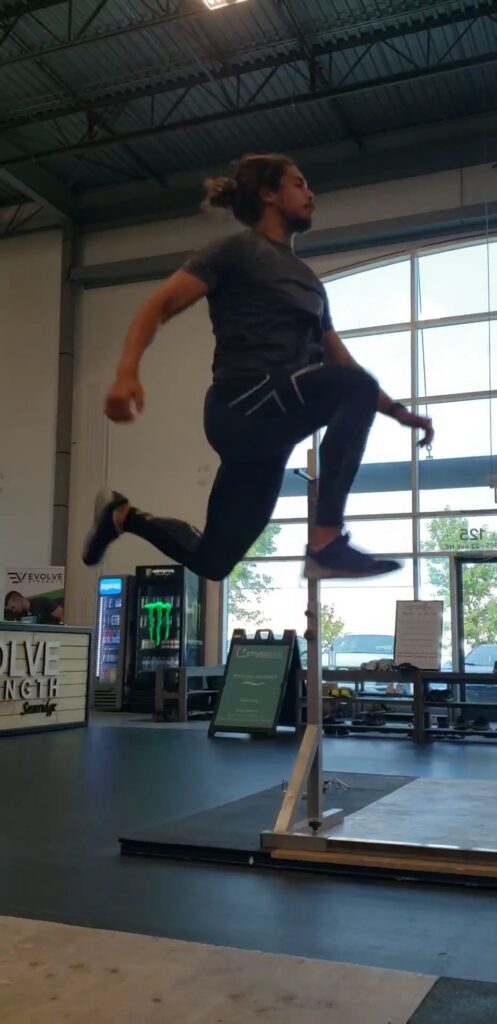Exercise Prescription for the Specific Characteristics of the SSC
We have come to the third and final part of developing the shock method. This article will focus on the last component of effective plyometric performance and training: Central Nervous System Stimulation.
Characteristics of Plyometric Performance
- Elastic Energy Recoil
- Stretch Reflex Potentiation
- Central Nervous System Stimulation – This article’s topic
Central Nervous System (CNS) Stimulation
Before you place a more powerful engine in an F1 car, engineers ensure that all the vehicle components can handle more power. Without the proper elements, there is no point in increasing engine power without the relevant factors because the car will break itself. The prior articles are essentially ensuring that all the body components relating to the Stretch-Shortening Cycle (SSC) are in order.
CNS stimulation is the final component of increasing pliometric and plyometric training performance and effectiveness. Unfortunately, it is easy to implement this component too early in training/development by introducing too much load too soon. Without the prior components of elastic recoil and stretch reflex potentiation, applying load to athletes can do more harm than good. Whether it’s too nonspecific to include the proper movement coupling (too long of ground contact) or if the execution of the movement is not to a high enough skill level (poor motor control). However, if optimal progressions are implemented for the athlete, CNS stimulation becomes the next step.
In the case of increasing CNS stimulation, plyometric and plyometric exercises need to be executed with greater impact and/or external forces. In other terms, we need to progressively overload these exercises utilizing increased stress and load.
How to increase the stimulation of the CNS
- Execute with greater impact or external force.
-
- Overload
- Utilizing weight/resistance added to the athlete while completing the exercise of choice.
- Multiple-impact plyometric exercise example
- Continuous barbell back squat, dumbbell, and kettlebell jumps.
- Continuous push-ups (hands leaving the ground) with variable assistance (band-assisted or weight added).
- Combined impact-pliometric and non-impact plyometric exercise examples.
- Discrete barbell back squat, dumbbell, and kettlebell jumps.
- Medball slams
- Overload
-
- Increasing kinetic energy accumulation
- Increasing the height of either the athlete or implement dropped to the athlete.
- Multiple-impact plyometric exercise example
- Depth drop to drop continuous rebounds.
- Continuous push-ups (hands leaving the ground) from plates of low boxes.
- Multiple-impact plyometric exercise example
- Combined impact-pliometric and non-impact plyometric exercise examples.
- Depth drops to vertical jumps.
- Partner medball ball drops to chest press
- Increasing the height of either the athlete or implement dropped to the athlete.
- Increasing kinetic energy accumulation
Progression examples for sprinting activities
Being a sliding athlete, I will demonstrate how I could implement a progression plan between two different sports: Skeleton and Bobsleigh. Both require tremendous speed and power, but the big difference is the amount of external resistance. A skeleton sled can weigh as little as 20 kg and upwards of 105-120 kg total combined weight, while a bobsleigh can top at 630 kg for 4-man bobsleigh. Now, these weights do include the athletes, but the main point is that a greater level is required for moving a bobsleigh. As such, each sliding sport requires a different approach.
- Increasing starting power with low levels of external resistance – Skeleton Example
- Multiple-impact Plyometrics
- Short and Long coupling time jumping exercises.
- See Part 2
- Externally loaded jumping exercises
- See above
- Lower absolute loads
- Short and Long coupling time jumping exercises.
- Multiple-impact Plyometrics
- Combined Plyometrics and Pliometrics
- Externally loaded jumping exercises
- Greater absolute loads
- Vertical jump with a barbell
- Greater absolute loads
- Externally loaded jumping exercises
- Classic Shock Method Exercises
- Depth Jumps to vertical jump
- Modify box height and number of contacts.
- Depth drop to horizontal jump(s)
- Modify box height and number of jumps
- Ensure that drop height is optimized for maximal horizontal distance.
- Depth Jumps to vertical jump
- Depth drop over multiple hurdles
- Combination of the above 2
- Modify both box height, hurdle height, and hurdle distance.
- Increasing starting power with high levels of external resistance – Bobsleigh Example.
- Multiple-impact Plyometrics – No external load
- Short and Long coupling time jumping exercises.
- See Part 2
- Short and Long coupling time jumping exercises.
- Multiple-impact Plyometrics – No external load
- Resistance Exercises
- Classical lifting
- Modifying exercise selection, TUT, intention, and load.
- Multiple-impact Plyometrics – Externally loaded
- Short and Long coupling time jumping exercises.
- Loaded but not compromising the technical execution of the exercise.
- Externally weight jumps
- Loaded but not compromising the technical execution of the exercise.
- Short and Long coupling time jumping exercises.
- Combined Plyometrics and Pliometrics
- Externally loaded jumping exercises
- Greater absolute loads
- Vertical jump with a barbell
- Greater absolute loads
- Externally loaded jumping exercises
- Classic Shock Method Exercises
- Depth Jumps to vertical jump
- Modify box height and number of contacts.
- Depth drop to horizontal jump(s)
- Modify box height and number of jumps
- Ensure that drop height is optimized for maximal horizontal distance.
- Depth Jumps to vertical jump
- Depth drop over multiple hurdles
- Combination of the above 2
- Modify both box height, hurdle height, and hurdle distance.
-
Note for inclusion of resistance exercises for Bobsleigh example and exclusion in Skeleton example.
- This is not a hard and fast rule for overall training but merely an example of plyometric training progressions. Implementing resistance training in both sports is a crucial component to overall progression.
- For high external load, resistance exercises are included to prepare the trainee for the multiple-impact plyometrics with external load.
See Part 1 and Part 2 articles
Don’t forget to Mobilize
Troy Wilson Wilson Kinetic Health, BScKinH, MScKin, PKin, Team Canada Athlete and RockTape Ambassador
